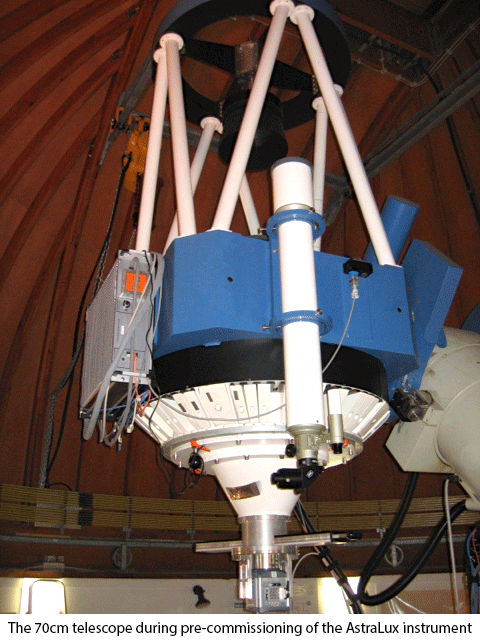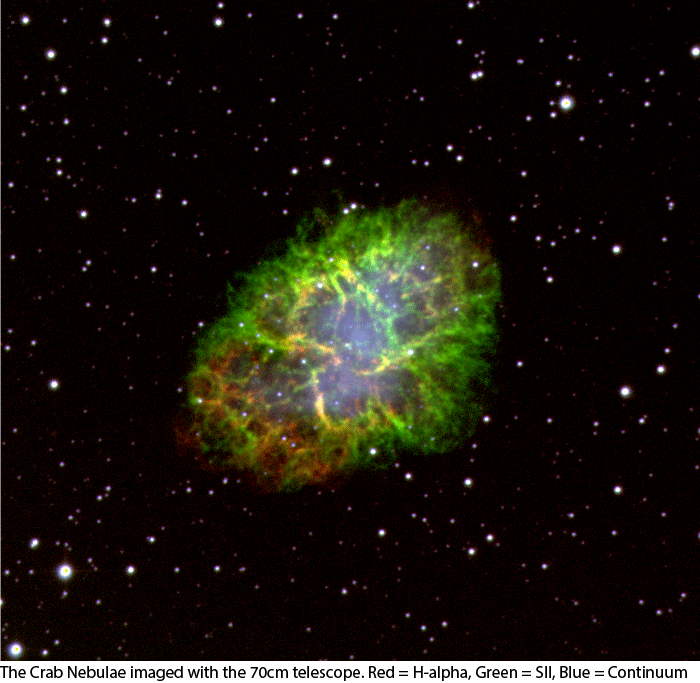| Version 24 (modified by , 12 years ago) (diff) |
|---|
The MPIA 70cm Telescope -- IAU observatory code 024
Right here, on top of the Heidelberg Koenigstuhl, the MPIA disposes of a reflector telescope with an aperture of 70 cm which has been dubbed KING - Königstuhl Instrument for Night sky Gazing / zum Nachthimmel-Gucken.
The telescope is maintained by the students in accordance with the MPIA. It is at present thanks to the work of the students and the support of the MPIA staff and directors in a very good shape and invites observations. Our website is designed to tell you how to prepare for observations, how to use the telescope and whom you should contact to get in touch.
Originally, the telescope was constructed for testing new instruments before sending them to Calar Alto and for publicity work at an open day. In 1995, a group of students proposed reactivating the telescope and making it available both for stargazing "just for fun", and for trying to realize small scientific projects. Following a proposal by M.Reuther et all. the telescope was overhauled and put into a working condition. That meant for example cleaning and readjusting the optical parts, and even acquisition of a disused CCD and electronics from Calar Alto. Well, the fun part is at present fully implemented. Pear through such a telescope visually is allways a delight. To go for a walk on the night sky, and see with his own eyes all these faint galaxies,nebulae and clusters is probably one of the dreams of every astronomer. The telescope is equipped with an ocularrevolver. The field of view is here 25'. For convenience there is also a binocular with a greater magnification (280X) and accordingly a smaller field of view (11').
You may also use the science CCD. It has a field of view of 15' times 15', which corresponds to 1024 times 1024 Pixels with a pixel scale of 0.9". The CCD is cooled to -120 degree Celsius by means of liquid Nitrogen. Parts of the electronic are similar to the one used on Calar Alto, as mentioned above. With just a few minutes exposure the camera reaches objects of 17th magnitude. Thanks to a newly improved tracking it is indeed now possible to integrate for ten minutes or even longer. With this camera students have the opportunity to learn vital observational techniques: how to stear a telescope or a camera, how to plan an observing run, how to monitor the data you get while you get it ... This all makes up a very good preparation for observations with bigger telescopes. And, naturally, we also take some beautiful pictures of known and not so known objects.

As the telescope starts to be fully usable, there are many ideas for science projects. For example Roland Jesseit has thought of conducting a survey to find planetary transits before stars of the Milky Way. One should be able to distinguish the signature of such an event from other variable stars quite easily. Christian Wolf has thought of tracking faint asteroids to determine their orbit.
Also students with interests in the more technical things, like computing, electronics, optics or mechanics can participate in the development of the telescope. There is much to learn about telescopes as a whole and their own hobbies in special. And sure it is a great thing to see how things work at last!
More information:
Attachments (6)
-
king70_astralux_ann.png (163.0 KB) - added by 12 years ago.
The 70cm telescope during AstraLux? pre-commissioning
-
king70_m1_ann2.png (219.4 KB) - added by 12 years ago.
The Crab Nebulae M1 imaged with the 70cm telescope
-
asteroid_mpia_citation_ann.png (12.4 KB) - added by 12 years ago.
Asteroid MPIA citation
- M51_Poster.jpg (304.0 KB) - added by 7 years ago.
- Picture_2-Dominik_Elsaesser.jpg (5.1 MB) - added by 3 years ago.
-
Picture_1-Dominik_Elsaesser.jpg (4.6 MB) - added by 3 years ago.
The 70 cm telescope from the air (© Dominik Elsässer)
Download all attachments as: .zip


